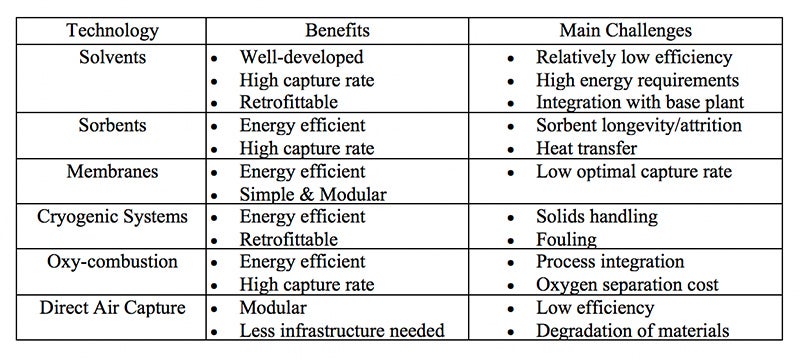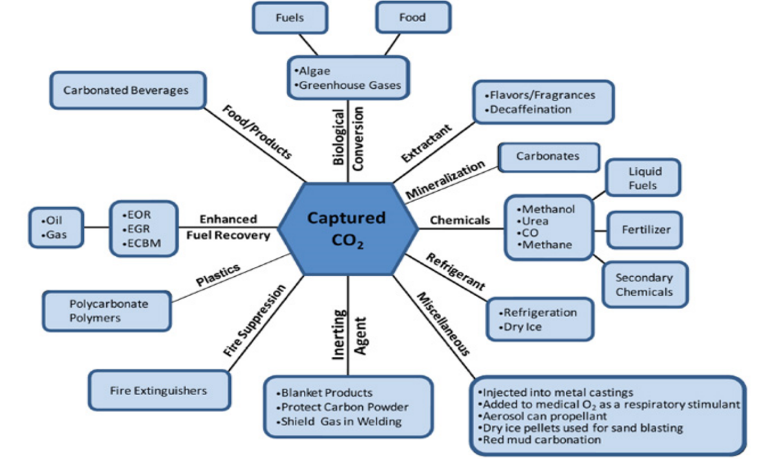Meeting the Paris Agreement requires immediate and all-inclusive action embracing deep decarbonization complemented by ambitious policy measures, protection, and enhancement of carbon sinks, biodiversity, and efforts to remove CO2 from the atmosphere. A recent modeling assessment put the potential for CO2 removal and storage using DAC at 16–30 billion metric tons per year in the 2070–2100 timeframe under different deep decarbonization scenarios.
There are good and bad ways to develop and use particular carbon removal options. Carbon removal contains many uncertainties, both in terms of the potential risks associated with large-scale deployment of many of these approaches as well as the ultimate potential of carbon removal.
The role of carbon capture and its use in climate policy
Carbon capture, utilization, and storage refer to the removal of carbon dioxide from the waste streams of industrial processes or the atmosphere, for storage underground or “recycling” into new products.
The challenge is scaling up CCU to capture and use millions or billions of tons of CO2 per year. Until that happens, CCU can not make a meaningful contribution to climate policy, however, it is still important to pursue certain types of CCU such as: point-source carbon capture, which could be attached to fossil fuel plants, bioenergy plants, or industrial facilities, is well-developed, but for financial reasons, it is not yet widely deployed.
In a report commissioned by the Institute for Carbon Removal Law and Policy, scholar Matthew Nisbet explains that carbon removal at the kinds of scales imagined by computer-based forecasts of climatic futures remains an untested and unproven proposition. There is a suite of technologies being developed for the capture, transport, storage, and utilization of CO2. These technological developments will progress in: (i) laboratory scale, (ii) pilot-scale, (iii) demonstration scale, and (iv) commercial scale.
CO2 transport
Transportation of CO2 includes>6500 km of CO2 pipelines worldwide (both on-shore and off-shore), most of which are associated with enhanced oil recovery (EOR) operation in the United States. As many commercial-scale CCS projects already use CO2-enhanced oil recovery. Saline formations have been used for CO2 storage at commercial-scale projects.
Deployment of large scale CCS projects
Of the 37 major large-scale CCS projects, 17 of these are in operation, four in construction, and the remainder are in varying stages of development. The majority of the commercial large-scale CCS projects are located in the United States and also has the greatest proportion of projects in operation. All but one of these projects, enhanced oil recovery is the primary storage for the captured CO2. The projects in the US have the largest CO2 capture capacity compared with projects in the rest of the world.
According to the Global CCS Institute’s 2019 Status Report, 40 million metric tons of CO₂ from plants currently in operation or construction are captured and stored each year. In the US alone, there are 10 large-scale operational facilities (power plants capturing 800,000 metric tons of CO₂ annually and other industrial facilities capturing 400,000 metric tons of CO₂ annually.)
Deploying CCS at a power plant or industrial facility generally entails three major steps: capture, transportation, and storage. Several different technologies can be used to capture CO₂ at the source. They fall into three categories: post-combustion carbon capture which is primary used in existing power plants, pre-combustion carbon capture which is used in industrial processes, and oxy-fuel combustion systems.
The Main Types of Carbon Captures

None of the technologies presented above are yet proven to work at scale, and each raises a set of environmental and social benefits and risks that are still poorly understood.
Deployment challenges
One of the most significant barriers to the widespread deployment of CCS technologies is the high cost of the technologies. Additionally, financial returns on a CCS project are riskier than normal operations so investors impose higher risk premiums which increases the private cost of the necessary capital. Mitigating risk for investors is vital for incentivizing investment and development of CCS. To realize full-scale deployment, additional research and development are required to optimize technology design and integration. Presently, the Department of Energy’s Carbon Capture Program is exploring these issues.
Public support is as critical to the widespread implementation of CCS
Several considerations play a role in public opinion about CCS such as acceptance of fossil fuels, acceptance of pipeline construction; perceived safety of transportation and storage of CO₂; the extent to which other climate solutions are implemented in addition to CCS. However, successful development and commercialization of technologies that transform captured CO2 into products may improve societal perceptions of CCUS and support the development of CCUS infrastructure.
So far carbon has been used to produce carbon fiber reinforced plastics which are used in the automotive industry, aerospace industry, sports equipment, and the oil and gas industry. Many studies have examined utilization technology in enhanced resource recovery, concrete, fuels, polymers, chemicals, minerals, carbon fibers, graphene sheets, and composites. There are also opportunities to convert CO2 into other products, including chemicals, fuels, and cement.

Figure 1 illustrates most of the current and potential uses of CO2 developed by the Carbon Utilization Research Council.
Policies related to CCS
As highlighted in the Intergovernmental Panel on Climate Change’s Special Report on Carbon Dioxide Capture and Storage, to accelerate CCS development, policies must increase demand and reduce the costs. Several different types of policies have the potential to bring down the costs of CCS and encourage development, and deployment, including carbon pricing policies, public investment and subsidies, and clean energy standards that credit companies generating electricity with CCS. National tax credits for carbon sequestration are created through Section 45Q of the Internal Revenue Code. Several tax credit and other crediting mechanisms exist at the state level such as in California, Texas, Louisiana, Montana, and North Dakota. Several other proposed policies could impact the rate of development for CCS, including the Launching Energy Advancement and Development through Innovations for Natural Gas Act, Enhancing Fossil Fuel Energy Carbon Technology Act, and the Fossil Energy Research and Development Act of 2019.
Jaylene Salas served as a 2020 summer intern with the Energy & Environment Program through the Colin Powell School for Civic and Global Leadership Fellowship Program where she focused on US energy policy. She is a recent graduate of the City University of New York City College where she earned a bachelor of science in applied physics and developed a passion for clean energy technologies.


